After reading friends' accounts of their pie-related celebrations on March 14, I wrote the following as a post for LTHforum.com - which started me on my annual celebration of constancy and comfort food:
It's Pi day, heralded all over town with various pie-related celebrations, several years worth of dedications on this forum alone...and our home was...pieless. I did, however, have one last batch of apples frozen from The Great Hays apple-picking & LTH whistle-stop tour of 2008, and it seemed appropriate that we make our own pie to celebrate the history of mankind's understanding of the universe's great constant, the circle.
It seemed only fair, then, that like the Egyptians building the Great Pyramids of Khufu, we begin our pie-making with a plan, so, off to the internet I went. Since I already had a standard 9" pie pan conveniently in the form of a circle*, I was relatively certain I could come up with a graphic representation of this great mathematical tool.
I tried an image search of pi, and to my delight, found that a retired Astrophysicist by the name of Mike Reed had discovered a crop circle near Banbury Castle in the UK was in fact a coded representation of the first ten digits of pi. So I had a plan - now to make a pie. I used my standard pie dough formula, except I subbed part of the water for vodka, making a wet pie dough that didn't have the proper chemical composition to create gluten. The resulting easily-worked dough was rolled out into two circles in my pie form; one was pressed into the pie pan and the other went into the freezer, still in the vinyl pie form, to make it easy to handle.
Having a plan is one thing: implementing it is something else entirely. If our pie-making ancestors could bake a pie with a living fully-armored knight inside, I was confident that I could muster the mathematical skills to put this graphic on my top piecrust. The first hurdle was to mark the piecrust into even tenths - not as easy as it appears. I can cut across the diameter like nobody's business, but once you get me past sixths, I falter.
Once again, I sought solace from the internet, which advised me I could overlay the circle with a pentagram, cut a radius from each of the five points, and then divide each wedge in half. Next problem: how do I create a pentagram on my piecrust? For this, I turned to my husband, who proved once again that, while I could easily have married him for looks and valor, I was fortunate to have made brains the deciding factor: he suggested I lay out the pentagram with chopsticks (also useful knowledge if I ever decide to eschew science and dabble in the dark arts.) So, I began laying out my pi pie:
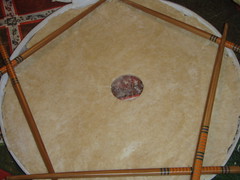 First, I used a cookie cutter to cut the circle out of the middle. Then, I set up the chopstick pentagram and drew a radius from each of its points.
First, I used a cookie cutter to cut the circle out of the middle. Then, I set up the chopstick pentagram and drew a radius from each of its points.Then, I divided each section into half, tracing out ten equal parts lightly with a knife point.
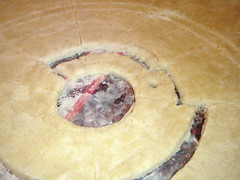 Then, I began to copy the code by outlining segments of my sections in a spiral, stepping out slightly for each number in pi: first three sections together, then, stepping out slightly along one radius, I outlined one, and poked a representation of the decimal point in it with one of the chopsticks.
Then, I began to copy the code by outlining segments of my sections in a spiral, stepping out slightly for each number in pi: first three sections together, then, stepping out slightly along one radius, I outlined one, and poked a representation of the decimal point in it with one of the chopsticks. I stepped out on its outer radius and outlined four more sections, and stepped out for the one, again for five, and finally, traced almost the entire crust for the nine. I used a marker top to cut out three circles for the ellipse to indicate the nearly infinite nature of pi. The now pi-embellished crust went back into the freezer to firm up. I then filled my pie with thawed apple filling, added raspberries for color, and placed my πcrust on the top.
It then went into a 350 degree oven for about an hour, (a wag friend suggested 360 degrees!) and came out delectable, hot, and redolent with prehistoric calculus. Like all things, inherent in its creation was its eventual and complete destruction...in a pool of melting vanilla ice cream.
* Through the magic of pi, we know that the circumference of my pie pan is just over 28 and a quarter inches. Its area is just over 63 and a half square inches.
I later got permission from Mr. Reed to post our correspondence, I thought you all might enjoy it as I found the insight into his thought process enlightening:
From: MHays
To: M. Reed
Subject: Pi day
I’m hoping I have the correct Mr. Reed – I wrote this post in celebration of pi day, using your discovery. Fascinating!
http://www.lthforum.com/bb/viewtopic.php?p=248901#p248901
Thank you,
Mhays
From: M Reed
To: MHays
Subject: Re:Delicious looking Pi
Dear Ms. Hays,
Your very ingenious Pi pie looked delicious!
The Barbury Castle formation was certainly an unusual event. I believe it is the only time a specific numerical constant has been explicitly encoded in a crop circle.
Thank you for sending the link to your article.
Best wishes,
M Reed
From: MHays
To: MReed
Subject: RE: Delicious looking Pi
Thanks for your reply! If I may ask – what clued you in? I spent about 20 minutes looking at your proof until I finally figured out that it was much simpler than I was making it. I can’t imagine just staring at the image and getting that it was divided into tenths.
From: M Reed
To: MHays
Subject: Re: Delicious looking Pi
Dear Ms. Hays,
The decimal point triggered the realization that the first segment was longer than the second but shorter than the third as in 3.14, which lead to looking at the next few segments, which started to sound like Pi (3.14159), which lead to drawing lines through the jumps in radius which lead to seeing ten sectors and counting the number of tenths of a circle in each segment. It was rather exciting to see the full ten digits come out of it including the proper rounding of the last digit.
Maybe a new formation this year will do something similar.
Best wishes,
M Reed
From: MHays
To: M Reed
Subject: RE: Delicious looking Pi
Thank you very much, Mr. Reed, you just explained why I’m a writer and not an astrophysicist. :D Do you mind if I post your responses with my pie?
MHays
From: M Reed
To: MHays
Subject: Re: Delicious looking Pi
Dear M,
Not at all.... Best wishes for your writing.
M Reed
OTOH, as a writer and not an astrophysicist, I did notice one thing about the crop circle: it was probably created by someone with a working knowledge of Indo-European languages, most likely English. For instance, while the ellipsis is represented by three dots in our culture, other cultures use different representations - apparently in Chinese the ellipsis has six dots. The grouping of the numbers into tens infers understanding that viewers have a working knowledge of the decimal system (which, though common, is not universal - an alternate, but infrequently-used way of grouping numbers is the duodecimal system, or base 12, which we use for time and in imperial measurements.) In addition, the decimal point itself is not universally used as a separator between the integer and fractional portion of a number: for example, a comma is used in France and Germany - two of the countries closest to where this crop circle occurred.And now back to your regularly-scheduled discussion of pie.
More Quips-style pi-related goodness:
Pi Day Recipe Collection

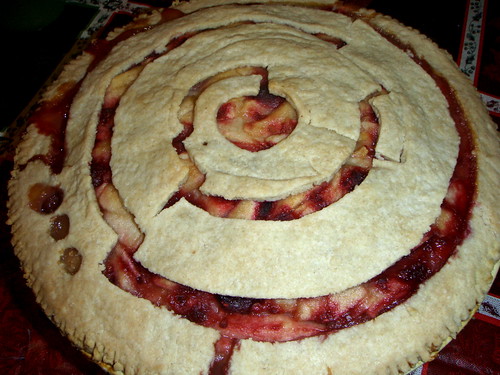
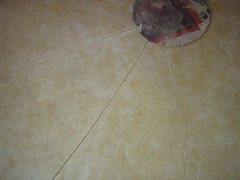
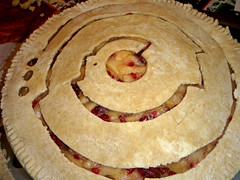
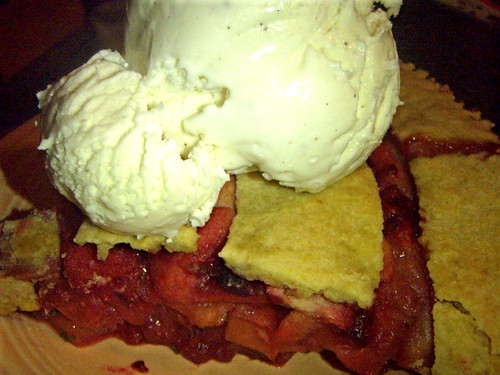




No comments:
Post a Comment